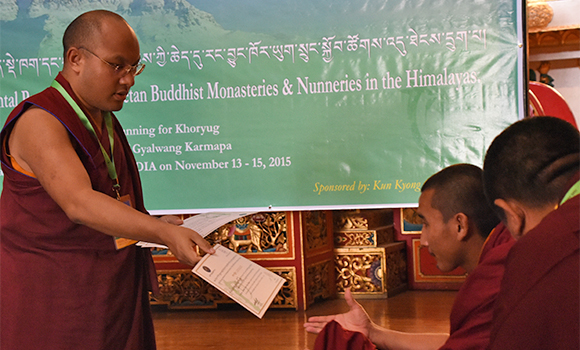
Norbulingka Institute, Dharamshala, India
November 15, 2015
With the goal of setting a positive example themselves, monks and nuns have been discussing for three days the environmental projects they want to pursue during the next five years. They voted on which issues were most important to them and the results were tallied. On this last day, final reports were presented to the Gyalwang Karmapa in four broad areas: implementation, communication, coordination, and organizational structure. In his talk to the gathering, he addressed each one.
First the Karmapa thanked in depth the monks and nuns who have been working for Khoryug and developing projects that have benefitted their monasteries, nunneries, and surrounding communities. He then turned to the main issues of the conference. First he asked, when we speak of protecting the environment what does implementation mean? It indicates, he answered, that we work not just for one or two days, but month after month, year after year, sustaining a flow of continuous activity. “Protecting the environment,” he explained, “does not mean merely planting some trees or painting a few signs on garbage cans. Our projects must have a real benefit and make a positive impact. They must have an effective cause and a clear result that everyone can see.” Just thinking “Well, I’ve done something” is not enough, he stated.
On a key topic of waste management, the Karmapa encouraged working with the local people. For example, here in the Dharamshala area, he suggested, we can connect with the local community and municipal authorities, as well as local Tibetan organizations, and monasteries in other places could do the same.
In general, he said, when we think about protecting the environment, there is a great deal of work to do so we have to reflect carefully about what we will take on. To assist such communication, the Karmapa suggested improving the Facebook page for Khoryug where the teams in the monasteries and nunneries can post reports and share their activities.
To facilitate the conference planning, the Karmapa set a fixed time for the yearly conferences, which will take place in different venues and last for four days. The topic for next year’s meeting will be natural disaster management, as it was in 2012, since the importance of focusing on training around this issue was made clear during the recent earthquake in Nepal when people suffered so greatly. For such times of natural disasters, he advised establishing in the monasteries and nunneries an emergency response team that could also reach out to local communities. He said that Khoryug would develop a training program specifically for these teams.
The Karmapa took a two-pronged approach to promoting environmental awareness and understanding within the Sangha. First he will use the occasion of the yearly Kagyu Monlam, when many monasteries and nunneries along with their leaders gather in Bodhgaya, to emphasize the importance of protecting the environment and to encourage all the monks and nuns to support the activities of Khoryug.
Secondly he will establish special awards for environmental excellence. They will be given to the nunnery and the monastery that were most creative and consistent in their efforts to promote the protection of the environment. The prize will also come with a financial reward to be spent on Khoryug projects.
In conclusion, His Holiness thanked all the monasteries and organizations, which for years have been working and taking on hardships. As a token of his appreciation, he gave each participant an elegant certificate of attendance and then, followed by all the participants, he climbed up to the roof of the shrine hall, whence one could clearly see the Himalayan range in all its majesty as the late day sun set it alive with burnished gold. Inspiration enough to continue this work of protecting the environment and all who dwell within.


